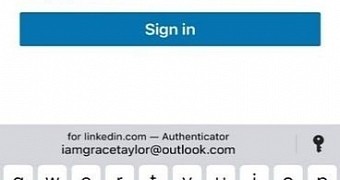Microsoft Authenticator is evolving substantially these days, and one of the priorities for Microsoft has become transforming this app into a fully featured password manager.
Microsoft Authenticator therefore can save passwords even for non-Microsoft accounts, and now the software giant is adding a new big feature to the app.
Authenticator now offers autofill options, and what’s more, it can become the default autofill provider on an iPhone thanks to the changes Apple introduced with iOS 14 – the operating system now allows users to change the system defaults, so other apps can now replace Apple’s on an iPhone.
In addition to the autofill engine, Microsoft Authenticator also comes with sync support, so your passwords roam across the devices, with similar capabilities on other platforms too.
“Microsoft Authenticator can now securely store and autofill passwords on apps and sites you visit on your mobile device. Once you make Authenticator an autofill provider, it will offer to save your passwords when you enter them on a site or app’s login page. Your synced passwords are protected on mobile with multi-factor authentication. These passwords are synced using your Microsoft account (outlook.com, hotmail.com, live.com, etc.), making them also available on your desktop with Microsoft Edge and the new Google Chrome extension,” the company says.
“While passwordless and multi-factor authentication is the way to go for security, we understand many sites still require passwords and some don’t even support multi-factor authentication. In a previous blog, we showed how no human generated password can be unique enough to beat attackers. That’s where Authenticator can help! Since you no longer need to remember passwords, Authenticator can autofill complex and unique passwords for you.”
How to use Microsoft Authenticator as the default autofill app on iPhone
Doing this pretty much comes down to a single toggle, but before anything, you need to make sure the autofill support is enabled in Microsoft Authenticator.
Before the feature is currently in beta stage, you must manually enable it from the settings screen, so head over to the configuration screen of Microsoft Authenticator and scroll down to the beta section. You should now see an Autofill entry, and simply tapping the toggle enables it.
Once Microsoft Authenticator benefits from autofill support, it should now be able to detect when you need your login credentials for a specific website and provide you with such information automatically.
The whole thing works just like the default iPhone implementation, so Microsoft has managed to make the experience feel as native as possible.
If you want to configure Authenticator as the default autofill provider on your iPhone, just follow this path on the device (you must be running iOS 14 for this feature):
Settings > Search for Autofill Passwords > Autofill Passwords > Authenticator
This is also possible on Android and the steps are pretty similar, so just search for Autofill passwords in settings and you’ll reach the option quite quickly.
“Autofill only works with Microsoft accounts (MSA), and is currently disabled for enterprise users who are using the Authenticator app for Phone sign-in or multi-factor authentication on their enterprise accounts,” Microsoft explains.
Overall, Microsoft Authenticator becomes a must-have app, not only for Microsoft users, but for others too. I’m currently using Enpass as my only password manager, and with the right improvements, Microsoft Authenticator could easily become a replacement that’s worth checking out.
For now, Microsoft is still beta testing this new feature, so it remains to be seen how everything would be further polished by the time the broad availability is announced.

 14 DAY TRIAL //
14 DAY TRIAL //